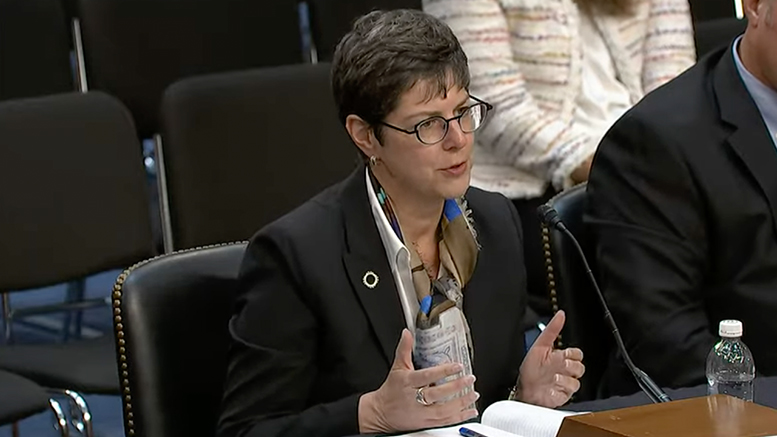The U.S. Joint Economic Committee, a panel comprising lawmakers from both congressional chambers that reviews economic conditions to recommend improvements in economic policy, held a hearing Wednesday about job training for the clean-energy transition.
Among the four witnesses at the hearing was Tracy Hartzler, president of Central New Mexico Community College (CNM) and a member of the American Association of Community Colleges ’ (AACC) board of directors. Hartzler acknowledged that community colleges are no strangers to working with employers to ensure job training programs are continuously relevant in current and emerging industries.
Community colleges, in part, “exist to serve our local workforce needs,” Hartzler said.
Evolving programs
CNM, for example, now offers an electrical trades solar electric certificate program, and its automotive technology associate degree program includes an introduction to hybrid and electric vehicles. In 2021, CNM built a 1.3-megawatt solar farm, which serves as a training lab for students in the electrical trades photovoltaic concentration program. The college also is in the process of building a new facility that will house its automotive and diesel technology programs, including a new electric vehicle technology program.
The college’s workforce arm, CNM Ingenuity, can deliver customized, short-term workforce training programs for current energy-industry employees. It also offers an electric lineworker pre-apprenticeship program in partnership with the New Mexico Rural Electric Cooperatives Association (NMRECA).
CNM isn’t unique to this. Other New Mexico institutions are training for new industries, too. Since 2019, more than 1,300 New Mexicans have graduated with credentials in renewable energy production, maintenance and engineering.
Changing lives
But all these programs don’t just meet employer needs – they provide entry points into careers, Hartzler said. And those careers can change lives.
During her testimony, Hartzler talked about Rita, a mother of two children who was struggling to make ends meet. Rita decided to enter the clean energy industry. At CNM, she started in the electrical trades program, completed the program within two years and was hired at a local electrical company. Now she can better provide for her family.
CNM was able to help Rita by providing critical student support so she could persist and complete the program.
Needed resources
To continue to serve students and employers, federal support is needed, Hartzler said. She mentioned the importance of programs like the U.S. Department of Labor’s Strengthening Community Colleges Training Grants, which AACC strongly supports.
Hartzler also encouraged Congress to support Pell for short-term programs, or Workforce Pell, to help “individuals seeking quick entry into the workforce and that quick start into a career that’s going to be successful for them and serve our communities, including our clean energy sector.”
She added that its “critical community colleges receive the federal support for jobs programs.”
“There’s no question that employers come to community colleges to design and provide responsive programming, and that learners come to us to find a better life and the resources and the programs they need to help them achieve their goals,” Hartzler said. “We are trusted, we are valued, we are capable and that’s why employers and students come to us.”
Apprenticeships needed
Though the clean energy jobs that people are training for may use different technology, job training is job training. Douglas Holtz-Eakin, president of the American Action Forum, noted that the skills needed to “build, operate and maintain facilities, such as wind farms and solar fields, are the same skills required across many other industries in the U.S. economy.”
He argued that, because of that, there’s no need for a federally funded program to train workers in green energy installation. Instead, he said, efforts should be on private sector training and supporting collaborative efforts that are already successful.
He also encouraged using registered apprenticeships because they “have a good track record.”
Courtenay Eichhorst, business manager for the United Association (UA) Local Union No. 412, agreed: “We like any job, whether it’s clean technology or old technology.”
Eichhorst talked about the importance of apprenticeship programs in meeting workforce demands – particularly registered apprenticeships. Policies that require registered apprenticeship programs are “fantastic,” he said, because they’ve increased the number of apprentices and they ensure there are steps to advancement and standards in place, he noted.
He’s also a fan of pre-apprenticeship or apprenticeship readiness programs that start in high school.
“It’s important to get in front of these students as early as possible,” he said, “and let them know they have a lot of opportunities.”
CNM’s Hartzler agreed that pre-apprenticeship programs, as well as dual-credit programs, are “so critical.” CNM works with 135 high schools to train students and expose them to work opportunities and to college while they can earn wages.
For example, CNM has forged a partnership with Rio Rancho Public Schools in its region, according to Hartzler’s written testimony. The partners have agreed to share a career technical education complex at the high school, where CNM’s trades programs will be embedded into the high school experience. The high school students can take trades courses for free taught by CNM faculty that count for both high school and college credit. In addition, the high school students will be able to participate in internships and apprenticeships with local employers.

